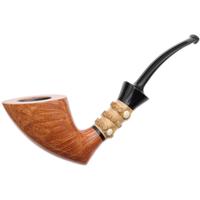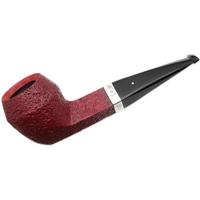Dunhill question
- Thread starter Commander McBragg
- Start date
You are using an out of date browser. It may not display this or other websites correctly.
You should upgrade or use an alternative browser.
You should upgrade or use an alternative browser.
Value is determined by what someone is willing to pay. If someone has no interest in a smooth pipe, but, likes a sandblast, he might not be willing to spend much on the former. Supply and demand factors in—Peterson pipes for example: these days, you see very few smooth, light finishes offered as compared to rusticated and sandblasted; the number of light, smooth, Pipe of the Year offerings is a fraction of the whole run (briar good enough for a light, smooth finish is in short supply it seems) and cost a good deal more.So again I was just curious about the value of sandblast vs smooth.
Pain in the ass to ream.What do you think of the opera shape?
Savinelli's Corallo di Mare used some of their highest quality blocks and shared a similar rustication with their Capri line. A finish that I much prefer to Castello's Sea Rock line.Same with savinellis.
If you the shape didn't do it for you, then forget it.The price was right that’s why I considered it. But the shape just wasn’t doing anything for me. I was curious what you thought
The shape is everything to me.
I don't understand smoking an angel hair straight grain or exception ring grain, if the shape is unappealing to me.
Yeah it looks like thatPain in the ass to ream.
thats why I came to the conclusion that for the price of a new Peterson I could get a nice quality estate. I have really nice pre 80’s Comoy’s I got for a steal.Value is determined by what someone is willing to pay. If someone has no interest in a smooth pipe, but, likes a sandblast, he might not be willing to spend much on the former. Supply and demand factors in—Peterson pipes for example: these days, you see very few smooth, light finishes offered as compared to rusticated and sandblasted; the number of light, smooth, Pipe of the Year offerings is a fraction of the whole run (briar good enough for a light, smooth finish is in short supply it seems) and cost a good deal more.
Yes I agree.If you the shape didn't do it for you, then forget it.
The shape is everything to me.
I don't understand smoking an angel hair straight grain or exception ring grain, if the shape is unappealing to me.
Above someone said that it cost more to blast a pipe than make a smooth. I never thought about it but can tell you that it takes a lot of work to get a smooth looking good. I never blasted any on the pipes I made, I would rusticate them like a Searock, but I did observe a maker doing blasting and it was very fast. As to rustication, you would be surprised how fast the guys at Castello can do a Searock. If anyone is interested here's the procedure I used. First grind the finish by hand with a multi nail headed tool. Next, brush it well with a steel brush. Then "paint" it with a weak solution of wood filler and water and let day. Now, buff it well with rag buffing wheel. Then, stain it red, let dry, buff again, stain black, buff again. And finally apply a light coat of button shellac, dry and lightly buff. And no, I didn't use any wax. If you want it to look good it takes time. 

That’s really neat. Thanks for that great bit of wisdom.Above someone said that it cost more to blast a pipe than make a smooth. I never thought about it but can tell you that it takes a lot of work to get a smooth looking good. I never blasted any on the pipes I made, I would rusticate them like a Searock, but I did observe a maker doing blasting and it was very fast. As to rustication, you would be surprised how fast the guys at Castello can do a Searock. If anyone is interested here's the procedure I used. First grind the finish by hand with a multi nail headed tool. Next, brush it well with a steel brush. Then "paint" it with a weak solution of wood filler and water and let day. Now, buff it well with rag buffing wheel. Then, stain it red, let dry, buff again, stain black, buff again. And finally apply a light coat of button shellac, dry and lightly buff. And no, I didn't use any wax. If you want it to look good it takes time.
Smooth typically has slightly higher value which only has to do with "perceived" briar quality.
In terms of either availability or aesthetics that could be true but it has absolutely zero to do with performance.
In terms of either availability or aesthetics that could be true but it has absolutely zero to do with performance.
I should also say I’ve watched how some sandblast and from what I’ve watched it is very fast. But as Searock said to make a smooth bowl takes some timeThat’s really neat. Thanks for that great bit of wisdom.
You can beat a Sandblasted pipe around more and it's much more forgiving. Outside of look preference, that's my main reason for preferring them over a nice looking smooth.
To get a block shaped to a stummel takes time. At a certain point the pipe maker either has the smooth shape they want, or they can make a slightly different shape if they come across flaws.I should also say I’ve watched how some sandblast and from what I’ve watched it is very fast. But as Searock said to make a smooth bowl takes some time
The degree of flaws that they come across at some point in the production will dictate whether the stummel is junk or if it can be salvaged by sandblasting, rustication, etc.
New sandblast pipes are usually cheaper than the same shape in a smooth, since most people put a premium on smooth pipes with vivid grain.
Thanks. That’s what I always thought. I notice most new Petersons that come out are always rusticated. Is that because they are lower grade briar? Just curiousTo get a block shaped to a stummel takes time. At a certain point the pipe maker either has the smooth shape they want, or they can make a slightly different shape if they come across flaws.
The degree of flaws that they come across at some point in the production will dictate whether the stummel is junk or if it can be salvaged by sandblasting, rustication, etc.
New sandblast pipes are usually cheaper than the same shape in a smooth, since most people put a premium on smooth pipes with vivid grain.
I originally thought I'd "migrate" to smooth & "pretty" pipes (& they would be more expensive) as I meandered along this path, but my sense of touch on my completely smooth pipes seems to lack a little in comparison to those that give me greater sensory input - thus I find I often prefer the "feel" of blasted or rusticated over the "look" of a smooth one.I guess I’m old school. I always thought smooth pretty grain was something someone would rather have vs sandblast. i just have been looking and keep seeing this trend in more than just dunhills. Was just curious
Yes this is mostly true of the old Dunhill pipes. In fact most pipe makers back then listed the sandblast and/or rusticated at a discounted price. Rusticated doesn't show the grain so any piece of briar (within reason) could be used. Sandblasted pipes can hide a lot of "sins" and don't show the full grain (think soft grain and birdseye).As the briar had flaws in it and thus the reason they sandblasted it.
Not to mention that the earlier craggy sandblasts in the 1920's-30's were being promoted by Dunhill so compared to their average grain pipes they were really "neat-o"Frankly, much of the Dunhill smooths are pretty average for grain, not really all that striking. But their sandblasts, especially the earlier craggy ones, have always been much in demand because they're much more visually interesting.
For the most part, you are right here also! That doesn't mean people didn't love the early Dunhill blasts but, for the most part, if you want a nice flawless straight grain pipe you will pay a premium.From what I read is if there was a flaw in the briar and sandblast could remove the flaw they’d keep it. If sandblast couldn’t remove the flaw they’d toss or very early on mark it as a second. But this is only what I read.
Of course there are exceptions to everything but I think you are correct in your assumptions and wondering why it was different for Dunhill pipes. Sable had the answer as far as the popularity of the shell and this was more than answered but I still wanted to "pipe in" as they say.
I think sandblasting can really bring out the grain in some pipes. I have a mix. I love a good bird's-eye or flame grain, but I also love me a good, craggy sandblast or rustication. Pictured is my 1924 Dunhill Shell and a new Lorenzo.
Attachments
Interesting. Which is which?I think sandblasting can really bring out the grain in some pipes. I have a mix. I love a good bird's-eye or flame grain, but I also love me a good, craggy sandblast or rustication. Pictured is my 1924 Dunhill Shell and a new Lorenzo.















